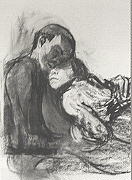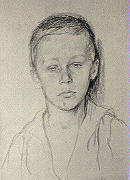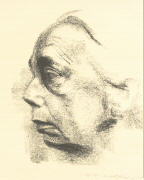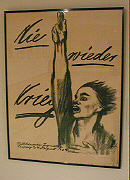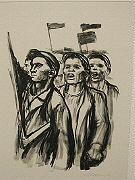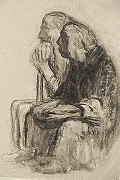
GALLERY VENUS
Käthe Kollwitz
Mother, Woman and Human Being
Today's society often puts Käthe Kollwitz to the far left, politically seen, which is only partly correct. The real concern of her art was to show the social grievances, which of course were largely concordant with the opinions of the Socialists and the Left Wings.
She also is said to be a forerunner of the feminist movement, but neither this is really true. Again it was mainly the social situation after the turn into the 20th century, which burdened the women extremely, due to theWorld War and the hardships between the wars, as there were unemployment, hunger and widowhood.
She was mainly an organ for the needy. She stood up for her principles and did not harden her heart, even if the doctor's practice of her husband granted a certain prosperity.
But Käthe Kollwitz was first of all a mother. Losing her son Peter in World War I was a blow, which she barely recovered from. Even if she tried to look at his - meaningsless - death as an "offer to the nation", she had to understand later, that "the people had not accepted her offer".
No wonder then, that her work is shadowed mainly by gloomy impressions, that need, despair and death are topics that dominate her art and that it is more than seldom that a smile lightens up the appearance of her mirrored persons.
Wanting to put Käthe Kollwitz into some category is therefore a wrong starting point, if one does not put her into the highest and most important category of them all: to be a Human Being.
Click on a thumbnail to see a larger picture.
Important facts from the artists life:
July 8th, 1867: born in Königsberg
1885 - 1889: studies in Berlin and München
1891: marries Dr. Karl Kollwitz, relocating to Berlin, first self-portraits
1892: son Hans is born
1893: participation at the "Freie Kunstausstellung in Berlin"
inspired by Hauptmann's drama "The Weavers", she starts the graphic circle "The Weavers' Uprising"
1896: son Peter is born
1902 - 1908: the circle "Peasant's War" is accomplished, travels during these years to Paris, Florence and Rome
1908 - 1910: drawings for the "Simplicissimus"
1910: first plastic artworks
October 23rd, 1914: son Peter is killed in the war
February 6th, 1919: becomes member of the "Preußische Akademie der Künste", gains title of professor
1919: first woodcuts
1922 - 1923: woodcut-series "War"
1934 - 1935: lithographic prints about "Death"
July 19th, 1940: Dr. Karl Kollwitz dies
September 1942: grandchild Peter is killed in Russia in the war
November 23rd, 1943: her studio in Berlin is bombed out, many artworks are destroyed
April 22nd, 1945: Käthe Kollwitz dies in Moritzburg near Dresden
Back to the  or to the or to the  of of 
last update: 29.3.2004 by
webmaster@werbeka.com
|

 or to the
or to the  of
of 
